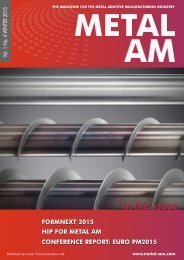AUTUMN
1SflouO
1SflouO
Create successful ePaper yourself
Turn your PDF publications into a flip-book with our unique Google optimized e-Paper software.
| contents page | news | events | advertisers’ index | contact |<br />
Metal AM part development<br />
redesign it accordingly. Wanting to<br />
know as much about my design as<br />
possible, I chose the latter option.<br />
Marcus’s test fixture was capable<br />
of applying 3750 Newtons to the part.<br />
My part withstood the whole thing.<br />
Marcus also used penetrating dye to<br />
confirm that the part didn’t have any<br />
micro fractures, and it came back<br />
negative (Fig.12). The part had met<br />
and exceeded the requirements for<br />
parts like it.<br />
It’s worth noting that this test<br />
is simply that: a test. It’s meant<br />
to simulate real world conditions<br />
and guarantee that the part meets<br />
generally accepted standards. But<br />
it simulates those conditions only<br />
generally; manufacturers of these<br />
kinds of parts will often have their<br />
own in-house spec that to tune the<br />
characteristics they optimise for.<br />
But in general, a designer needs to<br />
choose a test, and then optimise his<br />
design such that the part fails just<br />
beyond the test’s requirements. If I<br />
trust the ISO specification implicitly<br />
then it stands to reason that I should<br />
remove more material from the part;<br />
after all, it passed the test with a<br />
wide margin.<br />
Regardless, my part could be<br />
further optimised. What I’ve done<br />
to date was prove a basic concept:<br />
That metal powder bed fusion can<br />
be used to make thin walled bicycle<br />
parts. The question is: Can I make it<br />
commercially viable?<br />
Cost<br />
With the current design and an order<br />
quantity of ten pieces, the as-printed<br />
parts cost about $500 to make.<br />
Meanwhile, the most expensive<br />
commercially available seatmast<br />
topper I’m aware of costs $300, and<br />
the fanciest seatpost I’ve ever seen<br />
was under $600.<br />
Now, there are a number of<br />
interesting things to note here.<br />
First, I’m able to buy in fairly low<br />
quantities. It’s not unreasonable for<br />
me to purchase parts in batches of<br />
ten, which is about as low as any<br />
non-stock commercial product in<br />
the world and much lower than most<br />
products that involve forging, casting<br />
or CNC machining. If I can sell my<br />
Fig. 13 The new seatpost design, printed in EBM titanium by Addaero (Courtesy<br />
Spencer Wright)<br />
part at a high end price point, then it<br />
wouldn’t take much cost reduction<br />
before I’ve got a reasonable margin,<br />
even with a strikingly low order<br />
volume. Also, there are a number of<br />
ways that I can reduce cost on this<br />
part:<br />
• Even keeping the part’s design<br />
the same, I can reduce the cost<br />
by 25–40% by doubling the layer<br />
thickness. This will result in a<br />
rougher surface finish, but it’s<br />
possible that the difference will<br />
be acceptable.<br />
• A significant amount of time and<br />
effort can be saved by redesigning<br />
the underlying model so<br />
that the inner diameters need<br />
very little, or even zero, post<br />
processing. It’s unclear exactly<br />
how much work this will take,<br />
but it could reduce the price<br />
significantly.<br />
• Moreover, the entire part can be<br />
redesigned in order to reduce<br />
both the end mass and the<br />
amount of support structures<br />
necessary. Both of these have a<br />
big effect on price, though it will<br />
be time consuming to find an<br />
optimal design.<br />
All of this assumes that I stick with<br />
a laser powered process. Electron<br />
Beam Melting, which I’ve been<br />
experimenting with in parallel,<br />
might reduce cost further.<br />
Electron Beam Melting<br />
options explored with<br />
Addaero<br />
Last December, when I visited<br />
MicroTek in Cincinnati to learn about<br />
surface treatments, Tim Bell made<br />
a suggestion, “Why not try EBM as<br />
well?” Within the US job shop market,<br />
Electron Beam Melting is almost<br />
an afterthought. While there are<br />
many dozens of shops offering (and<br />
reselling, I’m sure) DMLS services,<br />
only a handful do EBM, and in general<br />
they tend to cluster even closer to a<br />
single industry.<br />
The closest of these to me is<br />
Addaero Manufacturing, which I first<br />
contacted in April. Since then, they’ve<br />
printed two iterations of prototypes<br />
for me. A few observations:<br />
• EBM’s surface finish is, for sure,<br />
noticeably rougher. This poses<br />
some interesting aesthetic<br />
questions (how much do<br />
consumers care about having a<br />
smooth, shiny part?), but there<br />
are practical matters as well.<br />
Rough finishes tend to create<br />
stress risers, which can result<br />
in significantly lower mechanical<br />
strength and fatigue life.<br />
• Because the process produces<br />
lower thermal gradients during<br />
the build, EBM generally results<br />
in much lower residual stress<br />
Vol. 1 No. 3 © 2015 Inovar Communications Ltd<br />
Metal Additive Manufacturing | Autumn/Fall 2015 49



